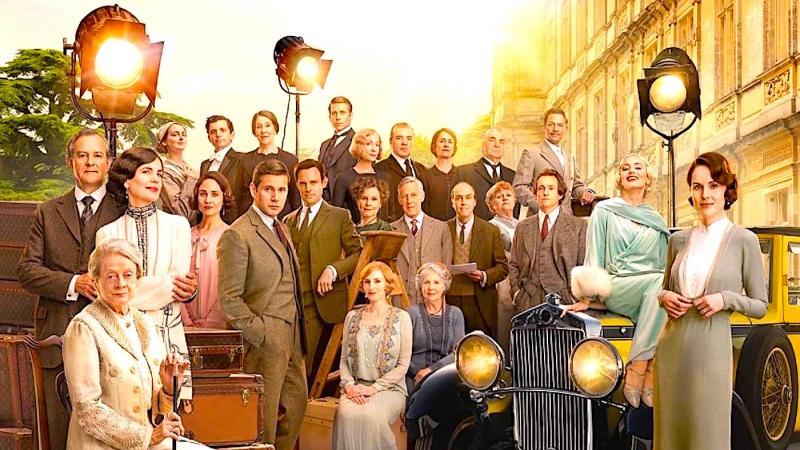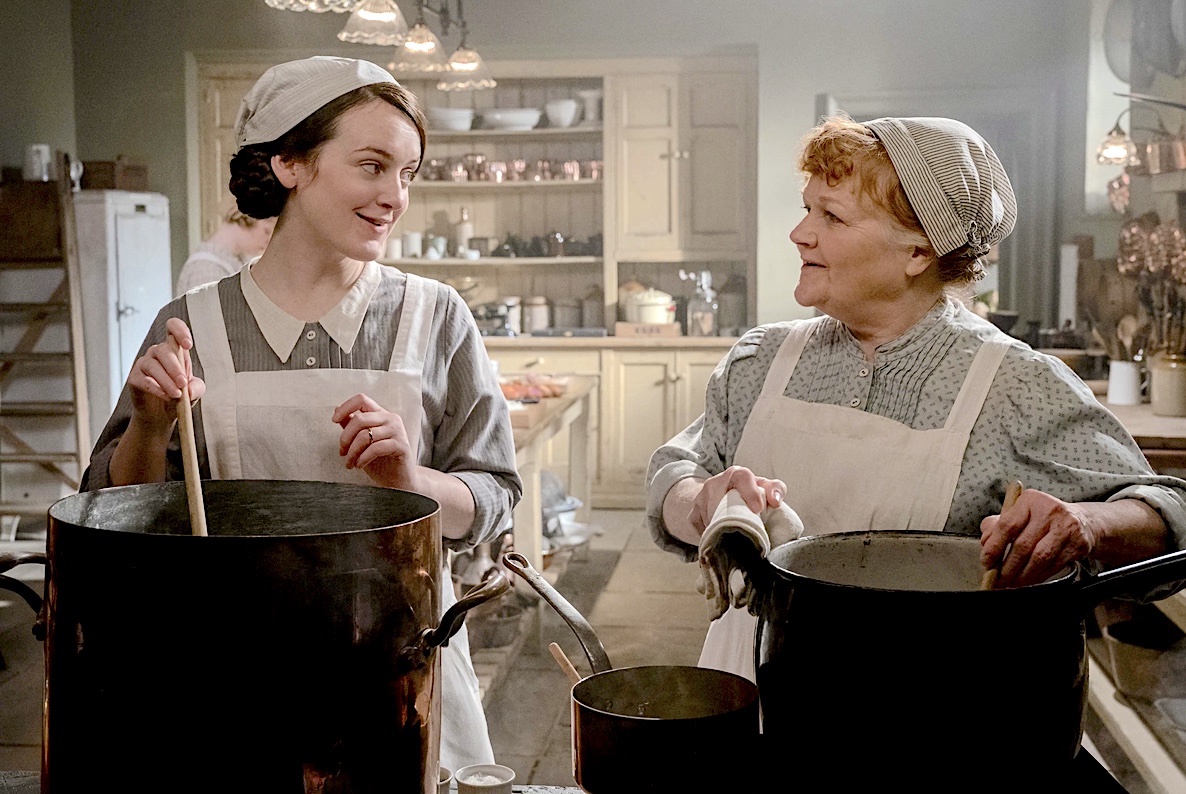Downton Abbey: A New Era review - will we ever see its like again? | reviews, news & interviews
Downton Abbey: A New Era review - will we ever see its like again?
Downton Abbey: A New Era review - will we ever see its like again?
Julian Fellowes goes transcontinental with this valedictory visit to the Crawley family

A dozen years have passed since Downton Abbey first landed on our TV screens, since when it has passed into folklore. Whether you thought it was escapist historical froth, a ludicrous anachronism full of class-system clichés or a documentary probing the British aristocracy, Downton has lodged itself in the national consciousness, probably forever.
However, perhaps even some of its most fervent fans thought that a belated second Downton movie was a bit of a stretch. The first one, from 2019, involved the arrival of King George V and Queen Mary at Downton, prompting panic attacks among family members who found they didn’t have a stitch to wear. This time, however, Downton’s creator Julian Fellowes (working with director Simon Curtis) has stretched the frame considerably to take in a pair of contrasting plots. At Downton Abbey, a film crew is gathering to shoot a moving picture, only to find itself left stranded by the galloping advance of technology. They’ve started out to make a silent movie, but the talkies are suddenly here and turning the industry inside out. The studio abruptly cancels the production. What is to be done? (Pictured below, Penelope Wilton as Isobel Crawley and Maggie Smith as the Dowager Countess)
 Meanwhile, most of the senior members of the Crawley dynasty have high-tailed it to the south of France aboard the Blue Train, to visit a splendid villa overlooking the Mediterranean which the Dowager Countess (Maggie Smith) has, somewhat to her surprise, inherited. It’s been left to her by the Marquis de Montmirail, with whom many decades earlier (we gradually gather) the young Violet Crawley was… friendly.
Meanwhile, most of the senior members of the Crawley dynasty have high-tailed it to the south of France aboard the Blue Train, to visit a splendid villa overlooking the Mediterranean which the Dowager Countess (Maggie Smith) has, somewhat to her surprise, inherited. It’s been left to her by the Marquis de Montmirail, with whom many decades earlier (we gradually gather) the young Violet Crawley was… friendly.
The Dowager, in failing health, has sportingly decided that she’ll give the villa to young “Sybbi”, daughter of the late Sybil Crawley (formerly the wife of the Irish chauffeur Tom Branson, now firmly affixed to Tuppence Middleton’s Lucy, who’s expecting their child). The Dowager confesses to Tom that “you weren’t quite what we had in mind for Sybil, but we got past it.” Meanwhile, the Crawleys have to weather a storm of pent-up resentment from the Marquis’s widow (an unlovable role for Nathalie Baye), who objects violently to the resplendent clifftop estate being handed over to the haughty English usurper. Then it occurs to everyone that the timetable of the Dowager’s youthful dalliance is aligned with extraordinary exactitude to her pregnancy with Robert (Hugh Bonneville, looking unusually trim and sportif). The whole Crawley edifice might be under existential threat!
This is all entertaining stuff, but the most fun is had with the film shoot back at Crawley Mansions. The Crawleys can barely suppress their disgust at the vulgarity of films and acting (“I’d rather earn my living down a mine,” shudders the Dowager), but the horror is ameliorated somewhat by the huge fee which the director Jack Barber (Hugh Dancy) offers for the use of Downton Abbey. There’s a splendid turn by Dominic West as rogueish movie star Guy Dexter (he lets slip that his real name Quintin Sidebottom), but while Dexter finds himself able to make the transition to talking pictures, his blonde-bombshell co-star Myra Dalgleish (Laura Haddock) is stymied by her ear-splitting cor-blimey accent (she was brought up in Borough Market, London SE1). Lord Fellowes loves playing with the clichés of class warfare, but he’s also a sentimental old fool, so balm is applied to Myrna’s discomfiture in an ingenious variety of ways by various Crawleys and members of the Downton staff.
 Lady Mary (Michelle Dockery) inevitably looms large in the story, though her husband Henry Talbot (Matthew Goode) is bafflingly absent from the proceedings altogether. This does give Mr Barber the opportunity to offer his services as romantic stand-in, and he has the privilege of escorting Mary to the Electric Palace in Thirsk to see the ground-breaking “talkie”, The Terror.
Lady Mary (Michelle Dockery) inevitably looms large in the story, though her husband Henry Talbot (Matthew Goode) is bafflingly absent from the proceedings altogether. This does give Mr Barber the opportunity to offer his services as romantic stand-in, and he has the privilege of escorting Mary to the Electric Palace in Thirsk to see the ground-breaking “talkie”, The Terror.
All the other Downton stalwarts have been given their moment in the spotlight – take a bow Mr Carson and Mrs Hughes, Anna and Mr Bates, Mr Molesley and Miss Baxter, Mrs Patmore and Mr Mason (pictured above, Lesley Nicol as Mrs Patmore and Sophie McShera as Daisy). There’s even a saucy little subplot for Thomas the butler (Robert James-Collier). All of this has stretched the running time to ungainly proportions, and exposes the crudeness of Fellowes’ technique of patching together a narrative from short, disconnected scenes.
But the film has soul, and its valedictory mood is embodied in a long and heartfelt farewell to Maggie Smith’s Dowager. The Dame has done it all in her storied and much-awarded career, but her role in Downton rocketed her into a different dimension.
rating
Share this article
The future of Arts Journalism
You can stop theartsdesk.com closing!
We urgently need financing to survive. Our fundraising drive has thus far raised £49,000 but we need to reach £100,000 or we will be forced to close. Please contribute here: https://gofund.me/c3f6033d
And if you can forward this information to anyone who might assist, we’d be grateful.

Subscribe to theartsdesk.com
Thank you for continuing to read our work on theartsdesk.com. For unlimited access to every article in its entirety, including our archive of more than 15,000 pieces, we're asking for £5 per month or £40 per year. We feel it's a very good deal, and hope you do too.
To take a subscription now simply click here.
And if you're looking for that extra gift for a friend or family member, why not treat them to a theartsdesk.com gift subscription?
more Film
 Islands review - sunshine noir serves an ace
Sam Riley is the holiday resort tennis pro in over his head
Islands review - sunshine noir serves an ace
Sam Riley is the holiday resort tennis pro in over his head
 theartsdesk Q&A: actor Sam Riley on playing a washed-up loner in the thriller 'Islands'
The actor discusses his love of self-destructive characters and the problem with fame
theartsdesk Q&A: actor Sam Riley on playing a washed-up loner in the thriller 'Islands'
The actor discusses his love of self-destructive characters and the problem with fame
 Honey Don’t! review - film noir in the bright sun
A Coen brother with a blood-simple gumshoe caper
Honey Don’t! review - film noir in the bright sun
A Coen brother with a blood-simple gumshoe caper
 The Courageous review - Ophélia Kolb excels as a single mother on the edge
Jasmin Gordon's directorial debut features strong performances but leaves too much unexplained
The Courageous review - Ophélia Kolb excels as a single mother on the edge
Jasmin Gordon's directorial debut features strong performances but leaves too much unexplained
 Blu-ray: The Graduate
Post #MeToo, can Mike Nichols' second feature still lay claim to Classic Film status?
Blu-ray: The Graduate
Post #MeToo, can Mike Nichols' second feature still lay claim to Classic Film status?
 Little Trouble Girls review - masterful debut breathes new life into a girl's sexual awakening
Urska Dukic's study of a confused Catholic teenager is exquisitely realised
Little Trouble Girls review - masterful debut breathes new life into a girl's sexual awakening
Urska Dukic's study of a confused Catholic teenager is exquisitely realised
 Young Mothers review - the Dardennes explore teenage motherhood in compelling drama
Life after birth: five young mothers in Liège struggle to provide for their babies
Young Mothers review - the Dardennes explore teenage motherhood in compelling drama
Life after birth: five young mothers in Liège struggle to provide for their babies
 Blu-ray: Finis Terrae
Bleak but compelling semi-documentary, filmed on location in Brittany
Blu-ray: Finis Terrae
Bleak but compelling semi-documentary, filmed on location in Brittany
 Oslo Stories Trilogy: Sex review - sexual identity slips, hurts and heals
A quietly visionary series concludes with two chimney sweeps' awkward sexual liberation
Oslo Stories Trilogy: Sex review - sexual identity slips, hurts and heals
A quietly visionary series concludes with two chimney sweeps' awkward sexual liberation
 Sorry, Baby review - the healing power of friendship in the aftermath of sexual assault
Eva Victor writes, directs and stars in their endearing debut feature
Sorry, Baby review - the healing power of friendship in the aftermath of sexual assault
Eva Victor writes, directs and stars in their endearing debut feature
 Blu-ray: Who Wants to Kill Jessie?
Fast-paced and visually inventive Czech comedy
Blu-ray: Who Wants to Kill Jessie?
Fast-paced and visually inventive Czech comedy
 Oslo Stories Trilogy: Love review - freed love
Gay cruising offers straight female lessons in a heady ode to urban connection
Oslo Stories Trilogy: Love review - freed love
Gay cruising offers straight female lessons in a heady ode to urban connection

Add comment